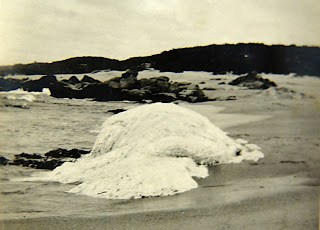As ShukerNature readers will no doubt already know, Trunko is the name that within my 1996 book The Unexplained I light-heartedly coined (but which to my great surprise duly became globally accepted) for the hitherto nameless yet very enigmatic 'sea monster' carcase washed ashore on a beach at the coastal town of Margate, in what is now Kwa-Zulu Natal, South Africa, during November 1924 (or 1922, according to certain dubious claims), and characterised by its coating of snow-white 'fur' plus a long elephantine trunk-like projection.
Sadly, no tissue samples were taken from this strange specimen for formal scientific analysis before it was washed back out to sea and lost forever; nor, seemingly, were any photographs snapped of it. Consequently, Trunko appeared destined to remain perpetually unidentified, eternally unexplained, but nonetheless inspiring all manner of highly imaginative but often extremely eyecatching artistic representations of what it may have looked like in life – bizarre hairy marine pachyderms bearing no resemblance to anything ever known to have existed on Earth.
Almost 90 years later, however, in September 2010, German cryptozoological co-researcher Markus Hemmler and I were very startled but delighted to discover no fewer than three Trunko photos, which had been snapped by a Mr A.K. Jones while this curious carcase had lain ashore.
One was featured on the Margate Business Association (MBA) website, the other two had been published in a Wide World Magazine article way back in August 1925 (click here and here to read my two world-exclusive ShukerNature articles that documented these extraordinary discoveries immediately after they had been made).
Yet until now, all three had remained entirely unknown to the cryptozoological community.
Moreover, these photos were of sufficiently good quality for me to be able to recognise that this entity was a globster, i.e. a decomposed whale carcase from which the skeletal contents have fallen away, leaving behind a thick gelatinous matrix of collagen protein, still encased inside the whale's skin sac of rotting blubber, with the carcase's famous 'trunk' most likely an enclosed rib covered in fibrous tissue, and the carcase's white 'fur' being exposed connective tissue fibres.
After more than 80 years, the mystery of Trunko had finally been solved (for full details, see my extensive May 2011 Fortean Times article – the most comprehensive coverage of Trunko's convoluted history ever published, and subsequently republished in ShukerNature Book 1). But that was not all.
In March 2011, I learnt from Markus that a fourth Trunko photograph had been discovered, by Margate-based South African artist and Trunko researcher Bianca Baldi, in the archives of Margate Museum, which showed an amorphous blob that again confirmed Trunko's identity as a globster (click here to read my ShukerNature account of this dramatic find).
And now, most recently of all, on 19 April 2022 and courtesy yet again of the indefatigable Markus, I was made aware of a fifth Trunko photo. As with the previous quartet, it had been hiding in plain public sight for quite a while.
Markus had discovered that on 4 March 2015, Margate businessman Lencel Celliers had posted in a Facebook group entitled 'MARGATE, Natal, South Africa – NOSTALGIA', a clickable link to a then-online album of vintage Margate-based photographs on the website of a South African news/Information channel called eHowzit that included two Trunko photographs. One of these is the Jones image that had appeared on the MBA website, but the other is entirely new to cryptozoologists.
The album provided no details concerning who had snapped this latter photo (it is reproduced here, at the opening to this present ShukerNature article, on a strictly non-commercial Fair Use basis for educational/review purposes only). As can be seen, it depicts the by-now familiar Trunko form of a huge white globster, but, interestingly, it shows a large fan-shaped projection from the carcase that was not visible in previous Trunko photos but which may explain various previously-mystifying claims by some original Trunko eyewitnesses that the carcase had possessed a lobster-like 'tail' (lobster tails are indeed fan-shaped). In addition, the specific location depicted in this photo, where Trunko was stranded, is revealed to have been the principal Margate beach at Tragedy Bay.
Markus subsequently contacted Mr Celliers on FB for more information regarding this highly significant photo, and Celliers replied that he had obtained both of them from the Margate Museum "when it was still in existence in 2000". (He also provided a link to a Margate-themed YouTube video produced by him and uploaded on 21 July 2012 that includes these same two Trunko pictures – click here to view it.) Presently unable to identify with certainty which establishment Celliers was alluding to, however, Markus speculates that it may in fact be the Margate Art Museum, but if so, it is still in existence today.
Consequently, Markus has now contacted this museum in the hope that it is indeed the correct one and can therefore provide some information concerning this fifth Trunko image.
My sincere thanks as always to Markus Hemmler for so kindly bringing this latest unearthed Trunko photo to my attention and for sharing with me his information concerning it.


























